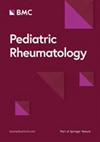C-reactive protein to albumin ratio as a prognostic tool for predicting intravenous immunoglobulin resistance in children with kawasaki disease: a systematic review of cohort studies
IF 2.8
3区 医学
Q1 PEDIATRICS
引用次数: 0
Abstract
Intravenous immunoglobulin (IVIG) is the primary treatment for Kawasaki disease (KD). However, 10–20% of KD patients show no response to IVIG treatment, making the early prediction of IVIG resistance a key focus of KD research. Our aim is to explore the application of the C-reactive protein to albumin ratio (CAR) for predicting IVIG resistance in children with KD through meta-analysis. Cochrane Library, PubMed, MEDLINE, EMbase, CNKI, WanFang, the Chinese Biomedical Database, and CQVIP were searched up to November 2023 for cohort studies on predicting IVIG-resistant KD using the CAR. Articles were selected based on pre-established inclusion and exclusion criteria after extracting literature data and assessing them using the QUADAS-2.0 tool for evaluating the accuracy of diagnostic tests. Stata 15.0 software was used for meta-analysis. Four Chinese and English literature reports were included in this meta-analysis. The results revealed the presence of a threshold effect and high heterogeneity among the included studies. The combined sensitivity for CAR predicting IVIG-resistant KD was calculated as 0.65 (95% CI 0.58–0.72), specificity as 0.71 (95% CI 0.57–0.81), and the area under the curve (AUC) as 0.70 (95% CI 0.66–0.74) using the random-effects model. The combined positive likelihood ratio was 2.22 (95% CI 1.35–3.65), the combined negative likelihood ratio was 0.49 (95% CI 0.35–0.69), and the diagnostic odds ratio was 5 (95% CI 2–10). CAR is an auxiliary predictive indicator with moderate diagnostic value that provides guidance in the early treatment of the disease, demonstrating a certain predictive value that warrants further investigation. However, CAR cannot yet be considered as a definitive diagnostic or exclusionary marker for IVIG-resistant KD. Therefore, multi-center, large sample, and high-quality long-term follow-up trials are warranted to confirm the current findings.将 C 反应蛋白与白蛋白比值作为预测川崎病儿童静脉注射免疫球蛋白耐受性的预后工具:队列研究的系统性回顾
静脉注射免疫球蛋白(IVIG)是治疗川崎病(KD)的主要方法。然而,10%-20% 的 KD 患者对 IVIG 治疗无反应,因此早期预测 IVIG 抗药性成为 KD 研究的重点。我们的目的是通过荟萃分析,探讨如何应用 C 反应蛋白与白蛋白的比值(CAR)来预测 KD 儿童对 IVIG 的耐药性。截至 2023 年 11 月,我们在 Cochrane Library、PubMed、MEDLINE、EMbase、CNKI、万方数据库、中国生物医学数据库和 CQVIP 中检索了使用 CAR 预测 IVIG 耐药 KD 的队列研究。在提取文献数据并使用用于评估诊断测试准确性的 QUADAS-2.0 工具对其进行评估后,根据预先确定的纳入和排除标准对文章进行筛选。使用 Stata 15.0 软件进行荟萃分析。本次荟萃分析共纳入了四篇中英文文献报告。结果显示,纳入的研究存在阈值效应和高度异质性。采用随机效应模型计算得出,CAR 预测 IVIG 耐药 KD 的综合灵敏度为 0.65(95% CI 0.58-0.72),特异度为 0.71(95% CI 0.57-0.81),曲线下面积(AUC)为 0.70(95% CI 0.66-0.74)。综合阳性似然比为 2.22(95% CI 1.35-3.65),综合阴性似然比为 0.49(95% CI 0.35-0.69),诊断几率比为 5(95% CI 2-10)。CAR是一个具有中等诊断价值的辅助预测指标,可为疾病的早期治疗提供指导,显示出一定的预测价值,值得进一步研究。然而,CAR 尚不能被视为 IVIG 耐药 KD 的明确诊断或排除标志物。因此,需要进行多中心、大样本和高质量的长期随访试验来证实目前的研究结果。
本文章由计算机程序翻译,如有差异,请以英文原文为准。
求助全文
约1分钟内获得全文
求助全文
来源期刊

Pediatric Rheumatology
PEDIATRICS-RHEUMATOLOGY
CiteScore
4.10
自引率
8.00%
发文量
95
审稿时长
>12 weeks
期刊介绍:
Pediatric Rheumatology is an open access, peer-reviewed, online journal encompassing all aspects of clinical and basic research related to pediatric rheumatology and allied subjects.
The journal’s scope of diseases and syndromes include musculoskeletal pain syndromes, rheumatic fever and post-streptococcal syndromes, juvenile idiopathic arthritis, systemic lupus erythematosus, juvenile dermatomyositis, local and systemic scleroderma, Kawasaki disease, Henoch-Schonlein purpura and other vasculitides, sarcoidosis, inherited musculoskeletal syndromes, autoinflammatory syndromes, and others.
 求助内容:
求助内容: 应助结果提醒方式:
应助结果提醒方式:


